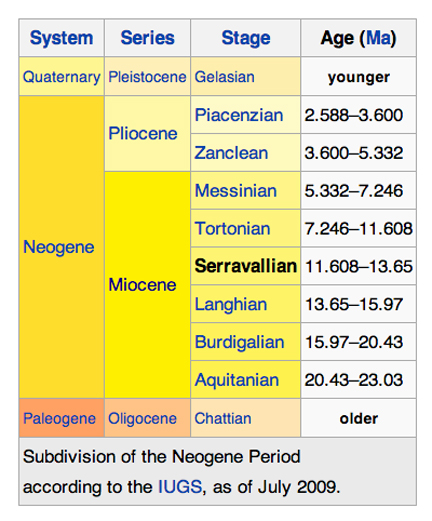From the department of “so much to tell, so little time”…
Above: looking north-northwest toward the Alps from the Cascina delle Rose in the village of Tre Stelle (Barbaresco), just north of Alba (see map below). I took that photo nearly four years ago on our honeymoon, the first week of February 2010.
As I was writing some copy for a client in the months that led up to the winter break, I set about researching something that had troubled me for a long time: even though wine writers commonly and widely (however erroneously) refer to the “Tortonian” and “Helvetian” subsoils of the Barolo appellation, geologists use the terms “Tortonian” and “Serravallian” to denote the two classifications.
Pick up any nearly any wine encyclopedia, guide or atlas to the wines of Langa, and you will find that they nearly unanimously point to the younger, “more compact” and “more fertile” Tortonian subsoils to the west of the road that leads from Barolo to Alba (see map below) and the older, “less compact” and “less fertile” Helvetian subsoils to the east.
Generally speaking, the wines from the west are more approachable in their youth and more generous with their fruit flavors while the wines from the east take longer to evolve and can be more austere and earthy in nature.
“The first soil type, calcareous marls of the Tortonian epoch which are relatively compact, fresher, and more fertile,” write the authors of the Barolo entry in Jancis Robinson’s excellent Oxford Companion to Wine, “characterizes the vineyards of the townships of La Morra and Barolo and produce softer, fruitier, aromatic wines which age relatively rapidly for a Barolo. The second soil type, from the Helvetian epoch, with a higher proportion of compressed sandstone, is less compact, poorer, and less fertile, with the result that the townships of Monforte d’Alba and Serralunga d’Alba yield more intense, structured wines that mature more slowly.”
Why, I’ve always wondered, do wine writers use the term Helvetian — from the ancient name of Switzerland — when the term Serravallian actually refers to a village in the Barolo appellation?
Above: the road that leads north from Barolo to Alba has long been cited as the division between the younger Tortonian subsoils (to the west) and the older “Helvetian” subsoils (to the east) that give wines raised in the Barolo appellation their distinct characteristics. The subsoils to the east are more properly referred to as “Serravallian,” after the village of Serravalle (in the lower right section of the map). Click here for the Google map.
Back in grad school, my advisor used to call me the segugio, the bloodhound: I was determined to get to the bottom of this conundrum.
After a long and delightful afternoon spent browsing Google books, I discovered the answer: the geologist who coined the term Serravallian in 1865, Lorenzo Pareto, died before he could “reiterate, and extend the definition with subsequent studies” (see the passages below). More than 100 years would pass before chronostratigraphers (how’s that for a 75-cent word!) would rectify this lithologic inaccuracy.
“In his paper introducing Langhian in the geological literature, wrote D. Rio et alia in “Langhian, Serravallian, and Tortonian Historical Stratotypes” (in Miocene Stratigraphy: An Integrated Approach, edited by Montanari and Coccioni, 1997), “[Lorenzo] Pareto (1865) also introduced the term Serravallian. Unfortunately, the author died the same year the paper was published and so could not further improve, reiterate, and extend the definition with subsequent studies, and defined the new name against potential competitors…”
“I would call this division of the Late Miocene era ‘the Serravallian stage,’ after the hamlet of Serravalle [wrote Pareto in the paper]…”
“The lower boundary of the stage coincides with the lithologic change from prevailing marls to prevailing sandstones.”
“The term Serravallian was used only for a short time in Italy after its introduction (Omboni, 1896; Stoppani, 1873), the type of which is older than the Langhian (Marks and Webbs, 1966). Even Sacco (1889), the greatest authority ofr the Cenozoic of the Piedmont Basin, used the Helvetian as the stage intermediate between the Langhian and the Tortonian, followed by the generality of geologists and stratigraphers. The name Serravallian was entirely forgotten for a long time. In the 1960s, with the realization the the Helvetain was time-equivalent to the Burdigalian (Congress of the Regional Committee on the Mediterranean Neogene Stratigraphy — RCMNS — Vienna, 1959), the term Serravallian was revived by several authors… At the RCMNS Congress held in Bratislava in 1975, a proposal was made to adopt the Serravallian in the standard Chronostratigraphic Scale as the second upper subdivision of the Middle Miocene, above the Langhian and below the Tortonian. Since then the term Serravallian has been adopted in all most recent Geologic Time Scales…”
Above: this chart comes from the Wiki entry for “Serrvallian.” The term is so widely accepted today that “Helvetian” has all but disappeared from geologic time scales.
Winemakers, wine writers, wine lovers, and Nebbiolophiles of all creeds and colors, please heed my call: Serravallian should be used instead of Helvetian!
Thanks for reading (if you made it this far)…




Nice entry (but then again I’m a geologist). Having said that, I’m now curious to see what the actual geological differences are. “Compact and fertile” bring to my mind a couple of things, but they are not geological in nature…
Bruce, thanks for the kind words. Take a look at the passage I quote: it describes the soils to the west as being dominated by marls and the soils to the east dominated by sandstone. And if you click through to the Google Books page, you’ll find a detailed description. It’s really fascinating. Thanks for reading and for being here.
Pingback: #52Drinks52Weeks - Barolo - iwbs
Pingback: #52Drinks52Weeks - Barolo - Indulge India
Pingback: Roagna’s 2014 Barolo Pira – Drinking Wine on West Vernor